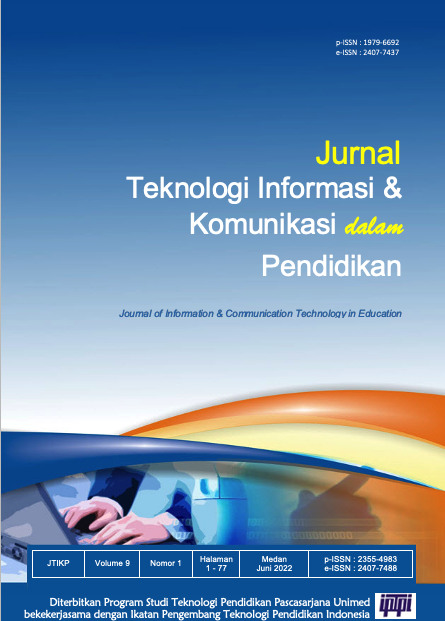PENGARUH SELF-EFFICACY PADA PENGGUNAAN MEDIA LiVE UNPAD TERHADAP MINAT BELAJAR DI MASA PANDEMI COVID-19
DOI:
https://doi.org/10.24114/jtikp.v9i1.30910Keywords:
Learning Management System (LMS), Media LiVE Unpad, E-Learning, 3-TUM (Tier Technology Use Model)Abstract
Abstrak: Media e-learning di masa pandemi COVID-19 menjadi elemen yang penting dalam proses belajar mengajar. Universitas Padjadjaran memiliki Learning Management System (LMS) bernama LiVE Unpad yang digunakan untuk pemberian materi, pengerjaan tugas, dan pelaksanaan ujian mahasiswa. Penelitian ini mengangkat sebuah topik mengenai rasa kepercayaan diri dalam menggunakan LMS LiVE Unpad (self-efficacy) memberikan pengaruh kepada bagaimana minat mahasiswa dalam menggunakan LMS ini melalui rasa kepuasan dan kegunaan LMS. Penelitian ini menggunakan 3-TUM (3-Tier Technology Use Model) untuk meneliti signifikansi dari kemampuan mahasiswa terhadap minat belajar menggunakan LMS LiVE Unpad. Pengolahan data menggunakan aplikasi SmartPLS untuk mendapatkan hasil penelitian yang akurat dan maksimal. Hasil penelitian menunjukan bahwa rasa percaya diri berpengaruh secara signifikan terhadap kepuasan menggunakan LMS LiVE Unpad dan rasa kegunaan LMS LiVE Unpad juga berpengaruh secara signifikan terhadap minat belajar menggunakan LMS LiVE Unpad. Penelitian ini dapat menjadi acuan untuk mengembangkan dan menyempurnakan media LiVE Unpad sebagai media pembelajaran di masa yang akan datang. Kata Kunci: Efikasi Diri, LiVE Unpad, E-Learning, COVID-19, Model 3-TUM Abstract: E-learning media in a pandemic COVID-19 is becoming a crucial element for learning process. Padjadjaran University has a Learning Management System (LMS) called LiVE Unpad for a learning purpose by giving subjects, assignments, and examination for its students. This research is raising a topic about how self-efficacy in using LiVE Unpad LMS is giving an impact to student™s behavioral intention by perceived satisfaction and perceived usefulness of LiVE Unpad LMS. This research is using a 3-TUM (3-Tier Technology Use Model) to observing the significance of student™s ability on LiVE Unpad toward behavioral intention of study. The data formulation is using SmartPLS application to get the maximum and accurate results. This research found that there are significance impact from self-efficacy to perceived satisfaction in using LiVE Unpad LMS and from the usefulness to behavioral intention of using LiVE Unpad LMS. This research could be a reference research for LiVE Unpad LMS to improve its media as learning media for students in the future. Keywords: Self-Efficacy, LiVE Unpad, E-Learning, COVID-19, 3-TUM ModelReferences
Aboagye, E., Yawson, J. A., & Appiah, K. N. (2020). COVID-19 and E-learning: The challenges of students in tertiary institutions. Social Education Research, 109“115.
Arikunto, Suharsimi. (2002). Metode Penelitian Suatu pendekatan Proposal. Jakarta: Rineka Cipta.
Aung, T. N., & Khaing, S. S. (2015). Challenges of implementing e-learning in developing countries: A review. Advances in Intelligent Systems and Computing, 405“411.
Bergstrand, K., & Savage, S. V. (2013). The Chalkboard Versus the Avatar: Comparing the Effectiveness of Online and Inclass Courses. American Sociological Association.
Bernard, R. M., P. C. Abrami, Y. Lou, E. Borokhovski, A. Wade, L. Wozney, P.A. Wallet, M. Fiset, and B. Huang. 2004. How does distance education compare with classroom instruction? A meta-analysis of the empirical literature. Review of Educational Research 74 (3):379“439.
Butnaru, G. I., Niță, V., Anichiti, A., & Brînză, G. (2021). The Effectiveness of Online Education during Covid 19 Pandemic”A Comparative Analysis between the Perceptions of Academic Students and High School Students from Romania. Sustainability, 13(9), 5311. MDPI AG.
Catro,M.D.B., & Tumibay,G.M. (2019).A literature review: efficacy of online learning courses for higher education institution using meta-analysis.
Davis, F. D., Bagozzi, R. P., & Warshaw, P. R. (1989). User acceptance of Computer technology: A comparison of two theoretical models. Management Science, 35(8), 982“1003.
Ghozali, I., & Latan, H. (2015). Partial Least Squares : Konsep, Teknik dan Aplikasi Menggunakan Program SmartPLS 3.0. Badan Penerbit Universitas Diponegoro.
Hair, J. F., Ringle, C. M., & Sarstedt, M. (2011). PLS-SEM: Indeed a silver bullet. Journal of Marketing Theory and Practice, 19(2), 139“152.
Hair Jr, J. F., Sarstedt, M., Hopkins, L., & G. Kuppelwieser, V. (2014). Partial least 2s structural equation modeling (PLS-SEM). European Business Review, 26(2), 106“121.
Hendriyana, A. (2021, September 8). Didampingi 400 mentor, 6.315 Mahasiswa Baru UNPAD IKUTI program TPB-OKK. Universitas Padjadjaran.
Henseler, J., Ringle, C. M., & Sarstedt, M. (2014). A new criterion for assessing discriminant validity in variance-based structural equation modeling. Journal of the Academy of Marketing Science, 43(1), 115“135.
Kriyantono, Rachmat. (2012). Teknik Praktik Riset Komunikasi. Jakarta: Kencana Penada Media Group.
Lam, T., & Hsu, C. H. C. (2006). Predicting behavioral intention of choosing a travel destination. Tourism Management, 27(4), 589“599.
Liaw, S.-S. (2007). Computers and the internet as a job assisted Tool: Based on the three-tier use model approach. Computers in Human Behavior, 23(1), 399“414.
Liaw, S.-S. (2008). Investigating students™ Perceived Satisfaction, behavioral intention, and effectiveness of e-learning: A case study of the blackboard system. Computers & Education, 51(2), 864“873.
Nguyen, T. (2015). The effectiveness of online learning: Beyond no significant difference and future horizons. MERLOT Journal of Online Learning and Teaching, 11(2), 309-319.
Noesgaard, S. S., & Ørngreen, R. (2015). The Effectiveness of E-Learning: An Explorative and Integrative Review of the Definitions, Methodologies and Factors that Promote e-Learning Effectiveness . The Electronic Journal of e-Learning, 13(4), 278“290.
Prifti, R. (2020). Self“efficacy and student satisfaction in the context of blended learning courses. Open Learning: The Journal of Open, Distance and e-Learning, 1“15.
Sarwono, J. (2010). Pengertian Dasar Structural Equation Modeling (SEM). Jurnal Ilmiah Manajemen Bisnis, 10(3), 173“182.
Sugiyono. (2015). Metode Penelitian Pendidikan; Pendekatan Kuantitatif, Kualitatif, dan R&D. Bandung : Alfaβ, CV.
Vertino, K., (September 30, 2014) "Effective Interpersonal Communication: A Practical Guide to Improve Your Life" OJIN: The Online Journal of Issues in Nursing Vol. 19, No. 3, Manuscript 1.
Wu, J.-H., Tennyson, R. D., & Hsia, T.-L. (2010). A study of student satisfaction in a blended e-learning system environment. Computers & Education, 55(1), 155“164.
Yulia, H. (2020). Online Learning to Prevent the Spread of Pandemic Corona Virus. ETERNAL (English Teaching Journal), 48-56.
Zaharias, P. Poylymenakou, A. (2009). Developing a usability evaluation method for e-learning applications: Beyond functional usability. International Journal of Human-Computer Interaction, 25(1), 75“98.
Zhang, D. 2005. Interactive multimedia-based e-learning: A study of effectiveness. American Journal of Distance Education 19 (3):149“62




